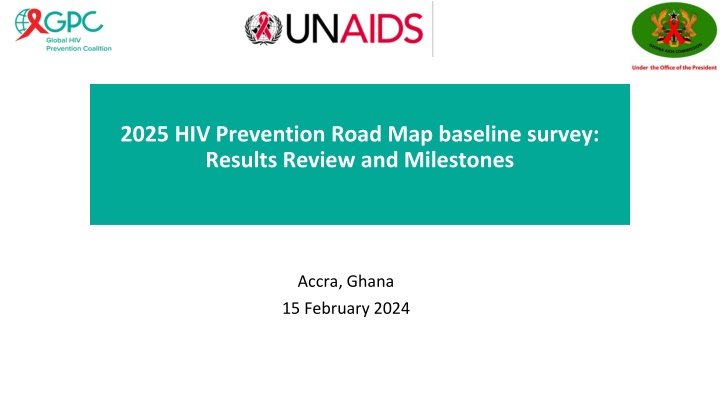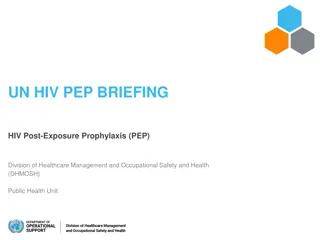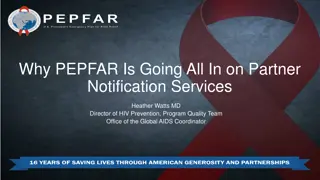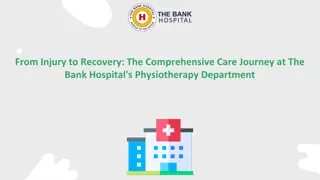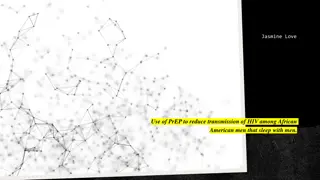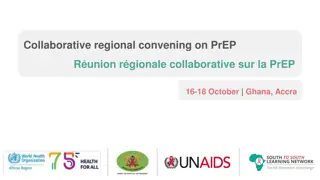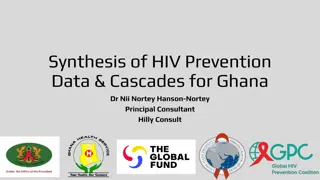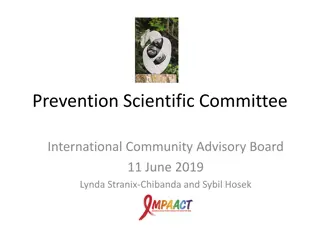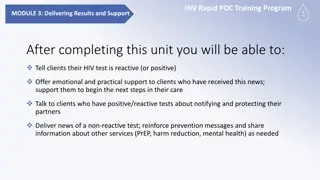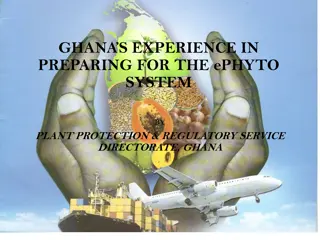2025 HIV Prevention Road Map Baseline Survey Review in Accra, Ghana
The Global HIV Prevention Coalition's 10-step action plan aims to meet HIV prevention targets by 2025 and end the AIDS public health threat by 2030. The baseline survey in Accra, Ghana, assessed the status of the 10 action points, with stakeholders reviewing results, identifying gaps, and prioritizing actions for future implementation and improvement.
Download Presentation

Please find below an Image/Link to download the presentation.
The content on the website is provided AS IS for your information and personal use only. It may not be sold, licensed, or shared on other websites without obtaining consent from the author.If you encounter any issues during the download, it is possible that the publisher has removed the file from their server.
You are allowed to download the files provided on this website for personal or commercial use, subject to the condition that they are used lawfully. All files are the property of their respective owners.
The content on the website is provided AS IS for your information and personal use only. It may not be sold, licensed, or shared on other websites without obtaining consent from the author.
E N D
Presentation Transcript
2025 HIV Prevention Road Map baseline survey: Results Review and Milestones Accra, Ghana 15 February 2024
OUTLINE Introduction The GPC Prevention RoadMap 10 Points Action Plan Roadmap Survey and Baseline Report 2023 Process of Stakeholder Review Stakeholders Feedback, Identified Gaps, and Priority Actions
Introduction The Global HIV Prevention Coalition (GPC) Road Map is a 10-step action plan for getting countries programmes on track to meet their HIV prevention targets for 2025 and end the public health threat of AIDS by 2030 Based on the 2021 UN Political Declaration on HIV and AIDS to provide effective HIV prevention services to 95% of people at risk of HIV infection and thereby contribute to reducing new HIV infections by more than 80% in 2025 compared to 2010 Using tools design by UNAIDS, countries assess their progress/state of implementation of the 10 action points through Surveys involving stakeholders and report to GPC/UNAIDS Results further reviewed and priority actions developed by in-country teams for implementation and improvement
2025 HIV Prevention Road Mapbaseline survey: Results Review and Milestones
Baseline status of Ghana 10 HIV Prevention 2025 Road Map Actions Completed Partially completed Not yet done
2025 HIV Prevention Road Mapbaseline survey: Results Review and Milestones Stakeholders were divided into three groups to: - Reflect on Road Map survey and baseline results, - Articulate gaps across the relevant prevention pillars, - Draft priority actions for 2024 onwards - Draft milestones aligned with 2025 Road Map, - Define the what, how and who, - Identify technical resources and support needed
Results: Stakeholder Feedback
Road Map Action Point 1: HIV prevention needs assessment Gaps and Priority Actions Identified Gaps National HIV prevention needs assessment not available at subnational level No targets for HIV prevention KP fallout due to the bill on Promotion of Proper Human Sexual Rights and Ghanaian Family Values There is currently no policy on the use of Naloxone for harm reduction interventions No consolidated annual program of work for all HIV interventions Priority actions Develop an HIV prevention needs assessment for subnational levels Develop HIV prevention targets at regional and district levels Intensify advocacy on right to health of KP community Train healthcare workers on full care treatment for KP community Intensify priority/targeted care access for KPs ( online services) Bring all HIV prevention actors under one umbrella (Reorganize, reconstitute the technical working groups. Encourage the technical working groups to National body to be proactive in bringing together actors through review meetings)
Milestones Proposed: HIV prevention needs assessment Milestones/Priority Actions Timeline How: Mechanism Who: Responsible entity Develop an HIV prevention assessment for subnational levels Mid year 2025 Review and adaption of existing prevention assessment tools by end of 2024 GAC Apply the tools at regional and subnational levels by June 2025 - GAC/NACP Dissemination of the response by end of 2025 - GAC PSAT tool to be adapted and applied at the regional level. Form a small group at the regional level to conduct an assessment. 4thQuarter 2024 Develop HIV prevention targets at regional and district levels Consultants/TA GAC and UNAIDS Start from the regional level.
Road Map Action Point 2: Precision HIV prevention approach Gaps and Priority Actions Identified Gaps Dissemination of the National strategic plan nationwide. Appears on the GAC website only. Accessibility with disability challenges not being addressed Adaptation from Global AIDS Strategy into the national and subnational AIDS Strategy Limited subnational targets for HIV prevention Priority actions Prioritization of the next National Strategic Plan. Current one is 2021-2025 Acceleration plan to complete the various hanging country documents including mid-term review of NSP, KP SOP. Packages for AGYW to be prioritized
Milestones Proposed: Precision HIV prevention approach Milestones/Priority Actions Timeline How: Mechanism Who: Responsible entity Who: GHS/NACP and GAC How: End term review of the current NSP Engagement with consultant, stakeholders, Validation, dissemination Who: GAC and supporting partners Dissemination of the revised NSP targets based on the mid- term review By the end of June 2024 How: Hybrid Stakeholder engagement Document must be available online Prioritization of the next National Strategic Plan. Current one is 2021-2025 (2026-2030) By the end of 2025 Accelerate completion of the various documents- KP SOP, stigma index 2.0 KP-SOP: By end of April 24 Stigma index: By end of Feb 24 How: Stakeholder engagement Who: SPH/NACP How: Validation and dissemination Who: GAC How: Validation and Dissemination Who: NAP+, WAPCAS and its partners Strategic plan for AGYW to be prioritized By the end of 2024 How: SBC strategy with emphasis on Social media strategies Who: GAC and partners
Road Map Action Point 3: Defining country investments for scaled HIV prevention response Gaps and Priority Actions Identified Gaps Need for granulated budget breakdown of plan to achieve 2025 HIV prevention targets Priority actions Granulated budget breakdown to inform/be informed by the plans in achieving the 2025 HIV prevention targets and beyond.
Milestones Proposed: Defining country investments for scaled HIV prevention response Milestones/Priority Actions Timeline How: Mechanism Who: Responsible entity Granulated budget breakdown to districts and regions across Ghana Q4 of 2025 How: As part of the development of NSP Who: GAC Pursue diversified resource mobilization approaches and partnerships End of 2025 How: Multistakeholder engagement Who: GAC, MOH/GHS
Road Map Action Point 4: Reinforcing multi-sectoral HIV prevention leadership Gaps and Priority Actions Identified Gaps Limited resources to fund the multi-sectoral collaboration oversight and management of the national HIV prevention response. Competing priorities of the multi-sectoral HIV prevention response team. The current national multi-sectoral approach does not include all the relevant actors in the HIV prevention response. No existing criteria to develop milestones Inconsistent quarterly review meetings to review HIV prevention status and data Priority actions Pursue diversified resources and partnerships to fund the multi-sectoral collaboration oversight and management of the national HIV prevention response. The HIV prevention coalition should be more representative of the relevant actors in the HIV prevention response. Community-led organizations should be empowered to lead the HIV prevention response. Orientation and action planning workshop of New Global HIV Prevention Coalition Countries Establishing criteria to develop and document milestones for evaluating progress on HIV prevention response.
Milestones Proposed: Reinforcing multi-sectoral HIV prevention leadership Milestones/Priority Actions Timeline How: Mechanism Who: Responsible entity GAC Pursue diversified resources and partnerships to fund the multi-sectoral collaboration oversight and management of the national HIV prevention response. Re-institute Quarterly Coordination meetings to review HIV Prevention status & data 2026 Quarterly starting now GAC Develop consolidated workplan and share in the first month of the year to guide planning December of every year. GAC / All Partners Develop a framework to clearly state the roles of various IPs & partners Current one (1) to be developed and should be by March 2024 GAC to coordinate with all agencies in HIV Orientation and action planning workshop of New Global HIV Prevention Coalition Countries
Road Map Action Point 5: Strengthening and expanding community-led HIV prevention services Gaps Identified Gaps Community-led HIV prevention services are not holistic, they are donor and agenda driven No targets set for increasing the proportion of HIV services delivered by community-led organizations Top-down approach to HIV prevention progamming where this is dependent on government and donors. Priority actions Develop a data repository on community HIV Service including data on prevention Develop a country specific strategy on community HIV Prevention that includes key actors & their roles with clear activities including an operational plan Get it high-level, covering a cross-cutting platform Different aspects of community approaches are implemented at different levels and scale and all need to be brought to the table so there is a Representative voice Cultivating a community practice on HIV prevention needs to reflect the Let Communities Lead Mantra
Milestones Proposed: Strengthening and expanding community-led HIV prevention response Milestones/Priority Actions Timeline How: Mechanism Who: Responsible entity Develop a data repository on community HIV Service including data on prevention End of 2024 PPMED / GHS, GAC Develop a country specific strategy on community HIV Prevention that includes key actors & their roles with clear activities including an operational plan July 2024 GAC / UNAIDS
Road Map Action Point 6: Addressing social and legal barriers to services for key and priority populations Gaps and Priority Actions Identified Gaps Fragmented references in the Policy No documents in place for some priority populations SoPs and NSPs are light on social, legal and structural barriers to services for key and priority populations Priority actions Standardise documents to especially address KP Populations in the context of KP work/SoPs NSP needs to incorporate structural issues and plans for addressing social and legal barriers and consolidate changes for all priority populations Need social protection and legal focal points Engage Parliamentary Select Committee on Health on the Bill
Milestones Proposed: Addressing social and legal barriers to services for key and priority populations Milestones/Priority Actions Timeline How: Mechanism Who: Responsible entity Develop document for addressing social, legal, barriers to with sections on the different groups NACP to build a coalition (TWG) to lead routine sessions, town-halls, to raise visibility on addressing social and legal barriers to services for Key and Priority Populations with the NSP a consolidated guideline December 2024 Rev Dr Ken Danso NACP SI team Dr Adu-Gyamfi Clinical care NACP
Road Map Action Point 7: Promoting integration to improve HIV outcomes Gaps and Priority Actions Identified Gaps The integration of the various health conditions alongside HIV are present but they are in progress and in some aspects inconsistent There is an underlying issue of health coverage for testing of these conditions that is lacking Priority actions Fast tracking the process of integration Addressing the cost component of these health conditions Integration of family planning in PMTCT services to avoid unwanted pregnancies
Milestones Proposed: Promoting integration to improve HIV outcomes Milestones/Priority Actions Timeline How: Mechanism Who: Responsible entity Integration of FP and HIV By end of 2025 How: Advocacy for the inclusion of FP in NHIS benefit package Who: MOH, NAP+, M2M, other stakeholders and partners Integration of MNCH and HIV By end of 2025 How: Advocacy for the inclusion of MNCH into HIV services Who: MOH/GHS, M2M Merging of Hepatitis and HIV services (It is parallel as it stands) By end of 2025 How: Advocacy for effective integration Who: MOH/GHS Integration of Mental Health into HIV care By end of 2025 How: Advocacy for effective integration Who: MOH/GHS Integration of NCDs into HIV services By end of 2025 How: Advocacy for effective integration Who: MOH/GHS Improvement of TB/HIV integration By end of 2025 How: Advocacy for the improvement, migration of cost onto NHIS
Road Map Action Point 8: Introduction of new HIV prevention technologies and programme innovations Gaps and Priority Actions Identified Gaps Periodic shortages of ARVs makes it difficult for multi-month dispensing Close expiry of HIV commodities Priority actions The country is to implement the action plans for the new HIV technologies and programme innovations like CAB-LA, vaginal ring Local production
Milestones Proposed: Introduction of new HIV prevention technologies and programme innovations Milestones/Priority Actions Timeline How: Mechanism Who: Responsible entity Acceleration of rollout of Vaginal ring and long acting PrEP regimen By the end of 2025 By the end of 2025 How: multi-stakeholder engagement Who: MOH/NACP How: Multistakeholder engagement Who: MOH/GHS How: Through multistakeholder engagement Who: MOH/GHS/NACP Improvement of commodity security to avoid shortages Sharing of milestones
Road Map Action Point 9: Establishment of real-time programme monitoring Gaps and Priority Actions Identified Gaps No sub-national score card/tool Priority actions Develop a sub-national score card/tool
Milestones Proposed: Establishment of real-time programme monitoring Milestones/Priority Actions Timeline How: Mechanism Who: Responsible entity Review and adaption of existing prevention score card tools by end of 2024 GAC Apply the tools at regional and subnational levels by June 2025 - GAC/NACP Dissemination of the response by end of 2025 - GAC Develop a sub-national score card/tool Mid 2025
Road Map Action Point 10: Strengthening accountability mechanisms of all stakeholders Gaps and Priority Actions Identified Gaps All interventions are unmarked in the accountability framework of the roadmap (no accountability framework) Priority actions Develop action plans to implement all the interventions in the accountability framework of the 2025 HIV Prevention Map. Develop and monitor an accountability framework that is infused in government and community leadership, transparency and sustainability.
Milestones Proposed: Strengthening accountability mechanisms of all stakeholders Milestones/Priority Actions Timeline How: Mechanism Who: Responsible entity How: Technical Assistance (Consultant) Identify and leverage on existing meetings of the various bodies and embedding accountability briefings and dialogues in line with the accountability framework Who: UNAIDS/GAC Develop an accountability framework (Develop action plans to implement all the interventions in the accountability framework of the 2025 HIV Prevention Map) End of 2024
Recommendations 1. Collaboration with key partners such as PEPFAR and The Global Fund is essential during the development of methodology tools for HIV prevention programs. 2. Ensure comprehensive coverage of Harm Reduction and Disability Inclusion interventions within HIV prevention programs. 3. Enhance visibility and engagement of the existing multi-sectoral HIV Prevention Working Group to ensure stakeholders understand its mandate and objectives. 4. Strengthen knowledge sharing and coordination among organizations working on HIV prevention to avoid working in silos. 5. Future surveys should gather evidence on the integration of HIV prevention programs with other health conditions and ensure consistency nationwide. 6. Develop a detailed breakdown of the HIV prevention budget to inform planning, coordination, and alignment with the National Strategic Plan.
Recommendations 7. Establish an acceleration process considering low overall prevalence but high incidence among key populations, including legal challenges faced by certain groups. 8. Consider consultancy to address specific challenges related to adolescent girls and young women, and develop a foundation of clear data for proposed social media strategies. 9. Accelerate the assessment and establishment of HIV prevention responsive structures. 10. Review global policies/strategies for integration into primary health care and universal health coverage. 11. Link new HIV technologies and program innovations to existing strategies like condoms and PrEP as part of scale-up efforts.
